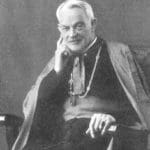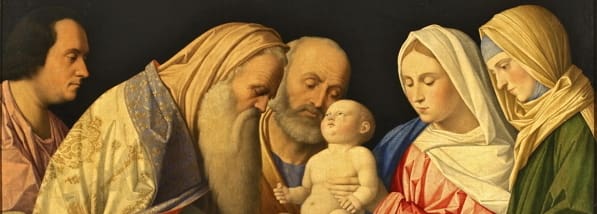THE CIRCUMCISION
“And after eight days were accomplished, that the Child should be circumcised, His name was called Jesus, which was called by the Angel before He was conceived in the womb.” Luke 2:21
1. We recognize at once in the simple narrative of these lives the immediate decision of Our Lady and St. Joseph that they will make no difference between themselves and others because of the Child that has been given to them. Other parents submit their children to the law by a certain definite ceremony; they will do the same with theirs, though they know Him to be above the law. Here as always their rule is that unless they receive some special intimation from above they will do the ordinary thing; probably indeed they were themselves so ordinary, and natural, and like everybody else, that it never occurred to them to act otherwise. We watch this characteristic working throughout the life of the Holy Family; Mary and Joseph act differently from others only when they have a special mandate to do so, and sometimes when that mandate might have been expected it does not come.
2. In this ceremony, Our Lord performs His first public act as man. He is born a Jew, under the law; therefore, as He said of Himself on a very similar occasion, when submitting to the baptism of John, it behooved Him to fulfill all justice.” On both occasions there is no question of His own individual need; but there is a distinct declaration that He  has made common cause with those who did need it. Circumcision had been enjoined on Abraham and his children as a sign of the covenant made with Him by God. It was a mark of these children, and of their faith in the promises of God. It implied also, as St. Paul teaches, the obligation to keep the Mosaic Law, once that Law had become established. Our Lord accepted Circumcision, as it were, upon these terms. His Circumcision fulfilled and gave power to all the circumcisions which had been administered under the covenant with Abraham, even as His Sacrifice gave power to all the sacrifices that had gone before. He then took away the rite once for all, in the new Christian Sacrament of Baptism, even as in the Sacrifice of the New Law He closed the sacrifices of the old.
has made common cause with those who did need it. Circumcision had been enjoined on Abraham and his children as a sign of the covenant made with Him by God. It was a mark of these children, and of their faith in the promises of God. It implied also, as St. Paul teaches, the obligation to keep the Mosaic Law, once that Law had become established. Our Lord accepted Circumcision, as it were, upon these terms. His Circumcision fulfilled and gave power to all the circumcisions which had been administered under the covenant with Abraham, even as His Sacrifice gave power to all the sacrifices that had gone before. He then took away the rite once for all, in the new Christian Sacrament of Baptism, even as in the Sacrifice of the New Law He closed the sacrifices of the old.
3. Catholic contemplation dwells upon the Circumcision as the first shedding of the Precious Blood. We feel with Mary and St. Joseph, who saw in this blood-shedding the beginning of our Lord’s life of bodily suffering. We feel that they must have known, even if only dimly, that this ceremony was of great significance both for the past and for the future; that the blood-shedding of Abel, and of all who had suffered or were to suffer, was in some way to find in this Child its sanction, its antitype, its consummation; that therefore through much blood-shedding would that Child come to His own. And on the other hand there was joy in their hearts at this further realization of the faithfulness of God. Now at last, with the Precious Blood of Christ, the “Lamb that was slain from the beginning of the world,” was the price of man’s redemption being paid. The blood of man, drawn from Our Lady’s own veins, was now at last of value sufficient to atone, because it became the blood of the Son of God. Upon this thought St. Paul continually meditates.
Summary Meditation Points:
1. The simplicity of the Holy Family, making itself exactly like others in spite of its honour, is nowhere more manifest than in the story of the Circumcision.
2. The Circumcision itself is the fulfillment of the Covenant in a double sense.
3. This first shedding of the Precious Blood is the beginning of the great work of Atonement, with all its sorrows and all its joy.
 Editor’s Note: This meditation is from Archbishop Alban Goodier’s “The Prince of Peace” (1913).
Editor’s Note: This meditation is from Archbishop Alban Goodier’s “The Prince of Peace” (1913).





